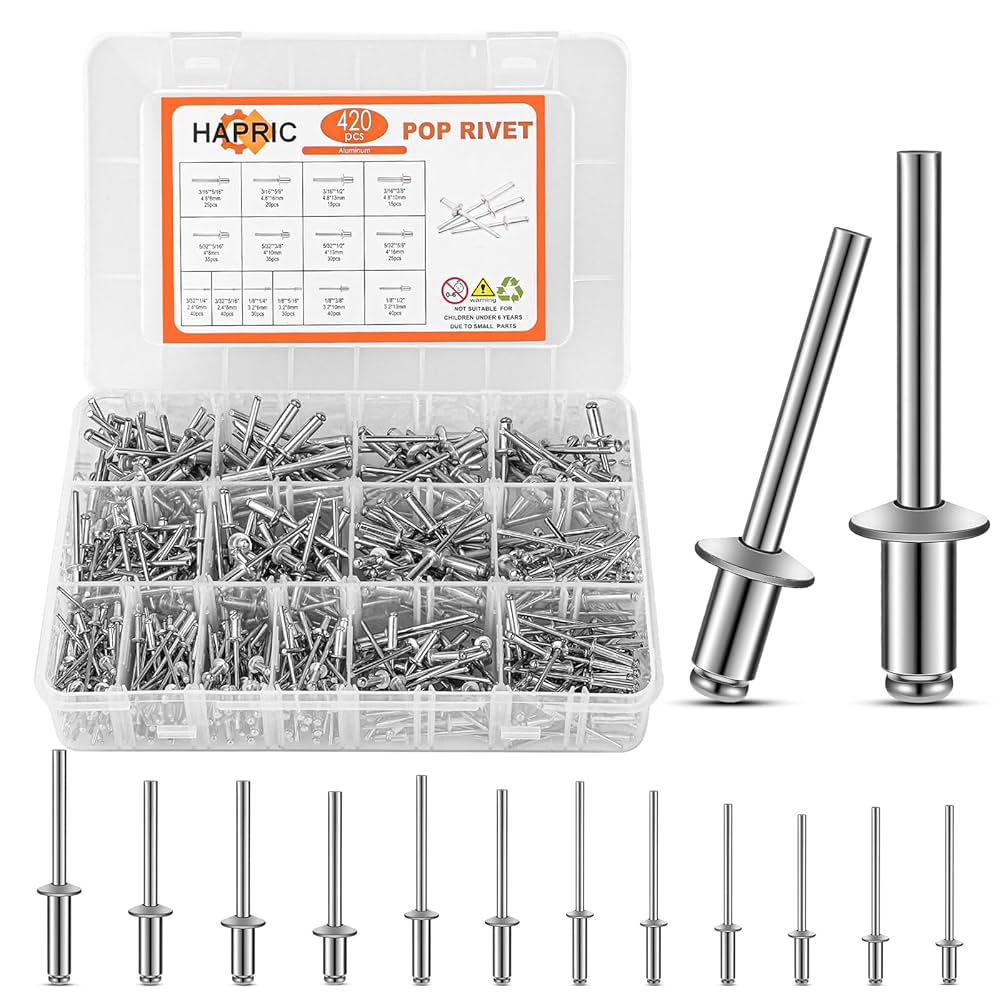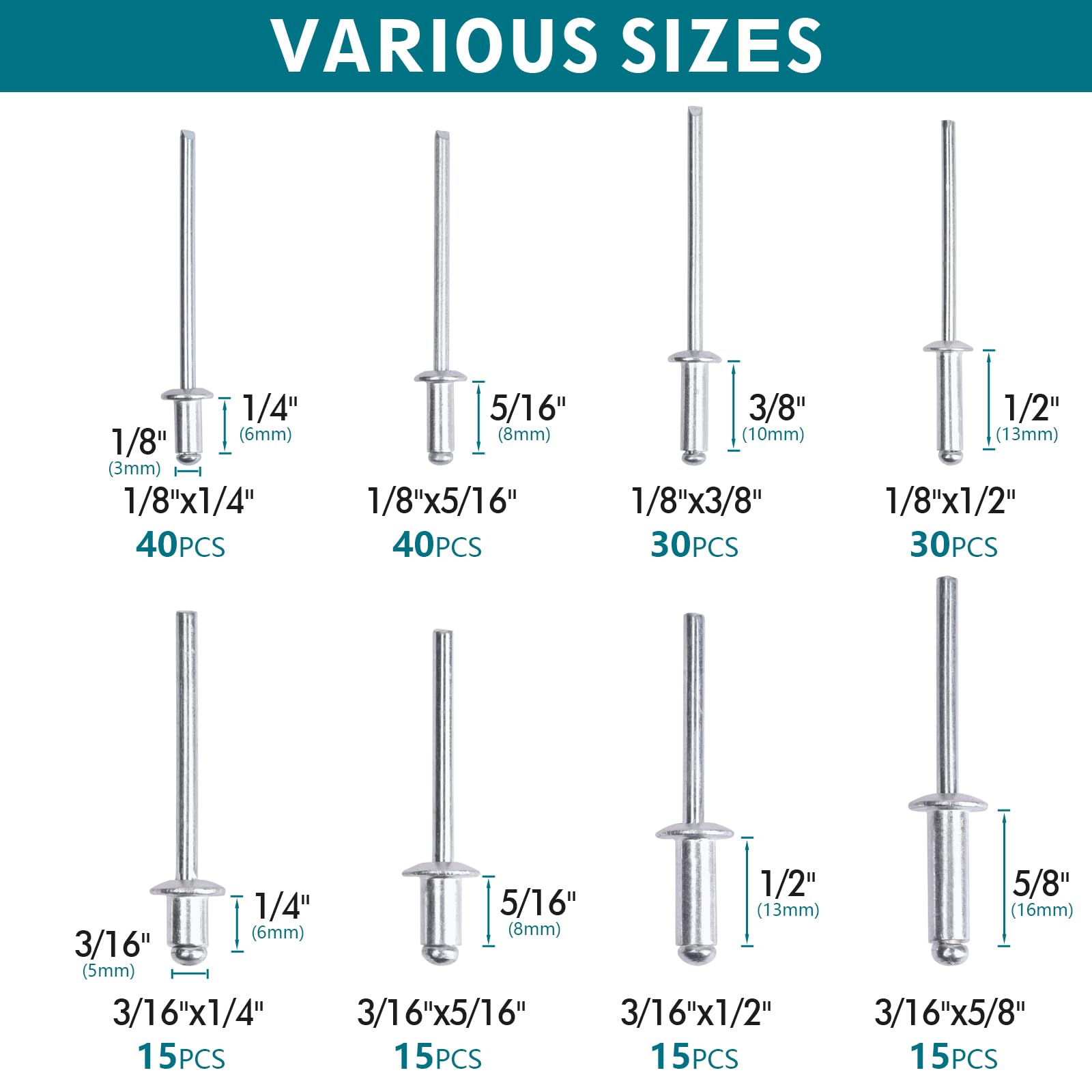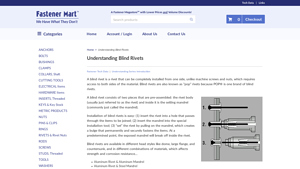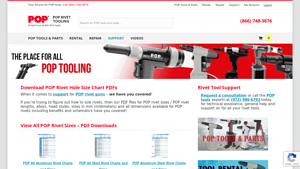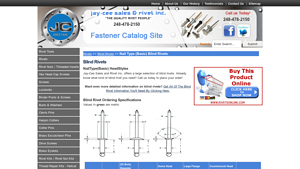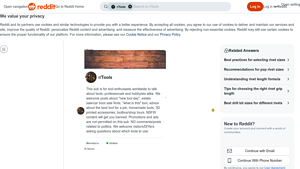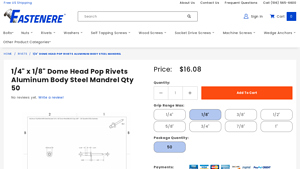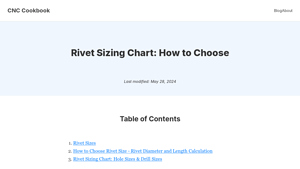Pop Rivets Sizes: The Ultimate 2025 B2B Sourcing Guide
Introduction: Navigating the Global Market for pop rivets sizes
In the dynamic landscape of global manufacturing, sourcing the right pop rivets sizes can present a significant challenge for B2B buyers, particularly in regions such as Africa, South America, the Middle East, and Europe. With an array of specifications, materials, and applications, navigating this complexity is crucial for ensuring the integrity and longevity of your projects. This comprehensive guide will delve into the various types of pop rivets, their specific applications, and essential considerations for supplier vetting and cost analysis, equipping you with the knowledge needed to make informed purchasing decisions.
Understanding the nuances of rivet sizes—including diameter, grip range, and material compatibility—can drastically impact the quality of your assemblies. For example, choosing between aluminum and stainless steel rivets can influence not only strength and durability but also cost-effectiveness. This guide aims to empower international buyers by providing actionable insights into selecting the ideal rivets for diverse applications, from automotive to construction and beyond.
By addressing critical factors such as installation ease, environmental resistance, and compliance with international standards, we ensure that you can confidently navigate the rivet market. Let this guide serve as your essential resource for optimizing sourcing strategies and achieving operational excellence in your fastener requirements.
Understanding pop rivets sizes Types and Variations
| Type Name | Key Distinguishing Features | Primary B2B Applications | Brief Pros & Cons for Buyers |
|---|---|---|---|
| Standard Blind Rivets | Available in various head styles; easy installation | Automotive, construction, and HVAC | Pros: Versatile, quick to install; Cons: Limited strength for heavy-duty applications. |
| Closed-End Blind Rivets | Solid blind end provides vapor and liquid-tight fastening | Marine, aerospace, and food processing | Pros: Enhanced sealing and strength; Cons: Slightly more expensive than open-end rivets. |
| Multi-Grip Blind Rivets | Adjustable grip range; accommodates varying material thickness | General manufacturing and assembly | Pros: Reduces inventory; Cons: May not provide optimal strength for all applications. |
| Bulb-Tite Rivets | Bulb-shaped head for larger grip area and increased strength | Heavy-duty applications, railways | Pros: High shear and tensile strength; Cons: Requires specific installation tools. |
| Structural Blind Rivets | Larger diameters and robust materials for heavy loads | Construction and structural engineering | Pros: Superior load-bearing capacity; Cons: Heavier and may require more substantial tools. |
What are the Characteristics of Standard Blind Rivets?
Standard blind rivets are the most commonly used type in various industries. They come in multiple head styles, such as dome and countersunk, making them suitable for a wide range of applications, including automotive and HVAC systems. Their ease of installation allows for quick assembly, making them a preferred choice for many B2B buyers. However, they may not be ideal for heavy-duty applications due to their limited strength.
How Do Closed-End Blind Rivets Enhance Application Performance?
Closed-end blind rivets feature a solid end that offers superior sealing capabilities, making them ideal for applications in marine, aerospace, and food processing industries where moisture and contaminants are a concern. These rivets provide enhanced strength compared to their open-end counterparts, ensuring a reliable fastening solution. While they may come at a higher price point, the added benefits of durability and performance often justify the investment for B2B buyers.
Why Choose Multi-Grip Blind Rivets for Diverse Applications?
Multi-grip blind rivets are designed to accommodate a range of material thicknesses, making them a versatile option for general manufacturing and assembly tasks. Their adjustable grip range helps reduce the need for multiple rivet sizes in inventory, streamlining supply chain management. However, while they offer convenience, buyers should consider that they may not provide the optimal strength required for all applications, particularly in heavy-duty scenarios.
What Advantages Do Bulb-Tite Rivets Offer in Heavy-Duty Applications?
Bulb-tite rivets are characterized by their unique bulb-shaped head, which provides a larger grip area and enhanced strength. This makes them particularly suitable for heavy-duty applications, such as in railways and construction. Their high shear and tensile strength make them a reliable choice for demanding environments. However, they do require specific installation tools, which can be a consideration for buyers looking to minimize equipment costs.
How Do Structural Blind Rivets Support Heavy Load Requirements?
Structural blind rivets are designed for applications that require robust fastening solutions capable of handling heavy loads. With larger diameters and made from durable materials, these rivets are commonly used in construction and structural engineering projects. Their superior load-bearing capacity ensures the integrity of structures. However, their heavier weight and potential need for more substantial installation tools may be a factor for B2B buyers to consider when selecting the appropriate rivet type.
Key Industrial Applications of pop rivets sizes
| Industry/Sector | Specific Application of pop rivets sizes | Value/Benefit for the Business | Key Sourcing Considerations for this Application |
|---|---|---|---|
| Automotive Manufacturing | Joining body panels and structural components | Provides strong, lightweight connections that reduce vehicle weight and improve fuel efficiency. | Ensure rivets meet automotive standards and specifications for tensile strength and corrosion resistance. |
| Construction & Infrastructure | Fixing metal frameworks and cladding | Offers quick installation and durability, essential for meeting tight project deadlines. | Consider local availability and compliance with building codes and regulations. |
| Aerospace | Assembling aircraft fuselages and components | Ensures high strength-to-weight ratios, critical for safety and performance in flight. | Prioritize aerospace-grade materials and certification for safety compliance. |
| Electronics | Mounting circuit boards and enclosures | Facilitates secure connections without damaging sensitive components, enhancing reliability. | Look for rivets that minimize electromagnetic interference and fit specific size requirements. |
| Marine Applications | Securing hulls and deck fittings | Provides resistance to corrosion from saltwater, ensuring longevity and safety at sea. | Source rivets with appropriate corrosion resistance ratings for marine environments. |
How Are Pop Rivets Sizes Utilized in Automotive Manufacturing?
In the automotive sector, pop rivets are essential for joining body panels and structural components. Their lightweight nature contributes to overall vehicle weight reduction, which enhances fuel efficiency. Buyers in this industry must ensure that the rivets meet strict automotive standards for tensile strength and corrosion resistance, especially in regions with varying climates, such as the Middle East and Europe.
What Role Do Pop Rivets Sizes Play in Construction & Infrastructure?
Pop rivets are widely used in the construction industry for fixing metal frameworks and cladding. Their quick installation capabilities allow for efficient project execution, crucial for meeting tight deadlines. International buyers should consider local availability of rivets and ensure compliance with regional building codes and safety regulations, particularly in Africa and South America, where construction standards may vary.
Why Are Pop Rivets Sizes Important in Aerospace Applications?
In aerospace manufacturing, pop rivets are critical for assembling aircraft fuselages and components. They provide a high strength-to-weight ratio, which is vital for maintaining safety and performance during flight. Buyers in this sector must prioritize sourcing aerospace-grade materials and ensure that all rivets are certified for compliance with industry safety standards, especially when dealing with international suppliers.
How Do Electronics Benefit from Pop Rivets Sizes?
In the electronics industry, pop rivets are used to mount circuit boards and enclosures securely. This application is particularly important as it allows for reliable connections without damaging sensitive components, enhancing the overall product reliability. Buyers should look for rivets that minimize electromagnetic interference and meet specific size requirements to ensure compatibility with their designs.
What Advantages Do Pop Rivets Sizes Offer in Marine Applications?
Pop rivets are invaluable in marine applications for securing hulls and deck fittings. Their resistance to corrosion from saltwater ensures longevity and safety for vessels operating in harsh marine environments. When sourcing rivets for marine use, it is crucial to select those with appropriate corrosion resistance ratings to withstand prolonged exposure to seawater, particularly for international buyers operating in coastal regions.
3 Common User Pain Points for ‘pop rivets sizes’ & Their Solutions
Scenario 1: Sizing Challenges Leading to Material Waste
The Problem: A common issue faced by B2B buyers is selecting the wrong size of pop rivets, which can lead to significant material waste and increased costs. When a buyer orders rivets that do not match the required grip range for their specific application, it can result in loose connections or rivets that fail to set properly. This not only compromises the integrity of the assembly but also necessitates additional orders and rework, causing delays and additional expenses.
The Solution: To avoid sizing errors, buyers should implement a thorough measurement and specification process prior to placing orders. Start by accurately measuring the total thickness of the materials being joined, including any backup washers. Utilize the provided grip range charts from reputable manufacturers to identify the correct rivet size that corresponds to your application. For example, if the total thickness is 0.200 inches, refer to a rivet size chart to select a pop rivet with a grip range that accommodates this thickness. Additionally, consider investing in a rivet gauge, which can help quickly identify the appropriate rivet sizes on-site, reducing the likelihood of ordering mistakes and ensuring that the right products are used for each job.
Scenario 2: Compatibility Issues with Installation Tools
The Problem: Another prevalent pain point arises when buyers discover that their current installation tools are not compatible with the selected pop rivet sizes. This issue can lead to operational disruptions, as teams may find themselves unable to set the rivets correctly or safely, impacting productivity and project timelines. In regions with limited access to specialized tools, this problem can be particularly frustrating.
The Solution: To mitigate compatibility issues, it is critical to ensure that the installation tools are matched to the specific rivet sizes being used. Buyers should consult the specifications of both the rivets and the installation tools before making a purchase. Manufacturers often provide compatibility charts that detail which tools work best with each rivet size and type. Furthermore, investing in adjustable or multi-size rivet guns can provide flexibility, allowing teams to work with a range of rivet sizes without needing multiple tools. If necessary, consider forming partnerships with suppliers who can offer tool rental or repair services to keep operations running smoothly and efficiently.
Scenario 3: Misunderstanding Material Strength and Corrosion Resistance
The Problem: B2B buyers sometimes overlook the importance of material selection concerning rivet strength and corrosion resistance, leading to failures in high-stress applications or environments with exposure to moisture or chemicals. For instance, using aluminum rivets in applications that require high tensile strength or in corrosive settings can result in premature failure, which can be costly in terms of both repairs and reputational damage.
The Solution: To address this issue, it is essential to conduct a thorough assessment of the application environment and the stresses that the riveted joint will encounter. Buyers should familiarize themselves with the different materials available for pop rivets—such as aluminum, steel, and stainless steel—and their respective properties. For high-strength applications, stainless steel rivets are recommended due to their superior tensile and shear strength. In corrosive environments, opting for closed-end rivets can provide additional protection against moisture ingress. Suppliers often provide detailed material data sheets; utilizing these resources can help buyers make informed decisions. Additionally, consider establishing a dialogue with suppliers to discuss specific application requirements, ensuring that the chosen rivet sizes and materials are well-suited for the intended use. This proactive approach minimizes the risk of failures and enhances the overall quality and durability of the final product.
Strategic Material Selection Guide for pop rivets sizes
What Are the Key Properties of Common Materials for Pop Rivets?
When selecting pop rivets for various applications, understanding the properties of the materials used is crucial. The most common materials include aluminum, steel, stainless steel, and brass. Each material has unique characteristics that influence performance, durability, and suitability for specific applications.
Aluminum: Lightweight and Corrosion-Resistant
Aluminum pop rivets are known for their lightweight nature and excellent corrosion resistance, making them ideal for applications in environments exposed to moisture and chemicals. They typically perform well under moderate temperature ranges, up to approximately 150°C (302°F).
Pros: Aluminum rivets are cost-effective, easy to install, and do not require extensive tooling for installation. They are suitable for applications in the automotive and aerospace industries where weight reduction is critical.
Cons: While they offer good strength-to-weight ratios, aluminum rivets are less durable than their steel counterparts and can deform under high stress. They are not suitable for high-temperature applications beyond their rated limits.
Impact on Application: Aluminum rivets are often used in applications where weight savings are essential, such as in aircraft and automotive manufacturing. However, they may not be ideal for heavy-duty structural applications.
Steel: Strength and Versatility
Steel pop rivets are significantly stronger than aluminum, with higher tensile and shear strength ratings. They are suitable for high-stress applications and can withstand higher temperatures, typically up to 300°C (572°F).
Pros: Steel rivets provide excellent durability and are often used in construction and heavy machinery applications. They are also more resistant to deformation under load compared to aluminum.
Cons: The primary drawback of steel rivets is their susceptibility to corrosion, which can be mitigated with coatings or galvanization. They are also heavier, which may not be suitable for applications where weight is a concern.
Impact on Application: Steel rivets are commonly used in structural applications, including bridges and buildings, where strength is paramount. They are also favored in manufacturing processes that require robust fastening solutions.
Stainless Steel: Superior Corrosion Resistance and Strength
Stainless steel pop rivets combine the strength of steel with enhanced corrosion resistance, making them ideal for harsh environments, including marine and chemical processing applications. They can withstand temperatures exceeding 500°C (932°F).
Pros: Stainless steel rivets are highly durable, resistant to rust and corrosion, and maintain structural integrity under extreme conditions. They are suitable for applications in the food and beverage industry, as well as in medical equipment.
Cons: The main disadvantage is their higher cost compared to aluminum and standard steel rivets. They also require specialized tools for installation due to their toughness.
Impact on Application: Stainless steel rivets are often used in applications where hygiene and corrosion resistance are critical, such as in food processing plants and marine environments.
Brass: Aesthetic Appeal and Moderate Strength
Brass pop rivets offer a unique combination of aesthetic appeal and moderate strength, making them suitable for decorative applications as well as for electrical connections due to their conductivity.
Pros: Brass rivets are resistant to corrosion and have a pleasing appearance, making them suitable for decorative applications in furniture and lighting.
Cons: They are not as strong as steel or stainless steel rivets and may not be suitable for load-bearing applications. Additionally, brass can be more expensive than aluminum.
Impact on Application: Brass rivets are often used in decorative applications and in situations where electrical conductivity is necessary, such as in electronic devices.
Summary Table of Material Selection for Pop Rivets
| Material | Typical Use Case for pop rivets sizes | Key Advantage | Key Disadvantage/Limitation | Relative Cost (Low/Med/High) |
|---|---|---|---|---|
| Aluminum | Automotive and aerospace applications | Lightweight and corrosion-resistant | Less durable than steel | Low |
| Steel | Construction and heavy machinery | High strength and durability | Susceptible to corrosion | Medium |
| Stainless Steel | Marine and food processing applications | Superior corrosion resistance | Higher cost and requires specialized tools | High |
| Brass | Decorative applications and electrical connections | Aesthetic appeal and conductivity | Moderate strength and higher cost | Medium |
This comprehensive analysis provides B2B buyers with the insights needed to make informed decisions regarding the selection of pop rivet materials, considering application-specific requirements and regional compliance standards.
In-depth Look: Manufacturing Processes and Quality Assurance for pop rivets sizes
What are the Key Stages in the Manufacturing Process of Pop Rivets?
The manufacturing process for pop rivets involves several critical stages to ensure the production of high-quality fasteners that meet diverse industrial requirements. Understanding these stages can help B2B buyers make informed decisions when sourcing rivets.
Material Preparation: What Materials are Used in Pop Rivet Production?
The first step in manufacturing pop rivets is material selection and preparation. Common materials include aluminum, steel, and stainless steel, each chosen based on the required strength, weight, and corrosion resistance. For aluminum rivets, the alloy type can vary, impacting both performance and cost.
Once the material is selected, it is cut into appropriate lengths, ensuring that it meets the specifications for various rivet sizes. The preparation may also involve the treatment of materials to enhance properties such as hardness and corrosion resistance.
How Are Pop Rivets Formed?
The forming stage is pivotal in shaping the rivets. This typically involves processes such as extrusion or stamping, where the raw material is shaped into the desired form. For pop rivets, the body is created with a hollow section that allows the mandrel to be inserted.
Various head styles, such as dome, countersunk, or large flange, are produced using specialized dies. The choice of head style can affect the rivet’s load-bearing capabilities and aesthetic finish, making it essential for buyers to specify their requirements clearly.
What Does the Assembly Process Entail for Pop Rivets?
In the assembly phase, the mandrel is inserted into the rivet body. This is a crucial step as the mandrel must fit snugly within the rivet to ensure proper installation and performance. The mandrel is often preloaded to facilitate easy setting during installation.
Quality control measures are integrated into the assembly process, where each rivet is checked to ensure that the mandrel is properly seated and that there are no visible defects in the rivet body. This step is vital for maintaining the integrity of the fastener.
What Finishing Techniques Are Used for Pop Rivets?
Finishing processes enhance the durability and appearance of pop rivets. Common techniques include anodizing for aluminum rivets, which improves corrosion resistance, and coating for steel rivets to prevent rust.
Other finishes may include passivation for stainless steel rivets, which helps enhance their resistance to corrosion and staining. The choice of finishing technique can impact the rivet’s performance in different environments, making it an important consideration for B2B buyers.
What Quality Assurance Measures Are Essential for Pop Rivets?
Quality assurance (QA) is a critical aspect of the manufacturing process, ensuring that pop rivets meet international and industry-specific standards. Understanding these QA measures can help buyers assess supplier capabilities effectively.
Which International Standards Should Buyers Consider for Pop Rivets?
Buyers should look for manufacturers that comply with international quality standards such as ISO 9001, which outlines criteria for quality management systems. Compliance with these standards indicates that the manufacturer has robust processes in place to ensure product quality.
Additionally, industry-specific certifications like CE marking for products sold in Europe and API specifications for oil and gas applications may also be relevant. These certifications ensure that the rivets meet specific safety and performance standards.
What Are the Key Quality Control Checkpoints in Pop Rivet Manufacturing?
Quality control in pop rivet production typically involves several checkpoints, including:
-
Incoming Quality Control (IQC): This step involves inspecting raw materials upon arrival to ensure they meet specified standards.
-
In-Process Quality Control (IPQC): During manufacturing, random samples are tested to monitor the production process and identify any deviations from quality standards.
-
Final Quality Control (FQC): Once production is complete, finished rivets undergo thorough inspections to verify dimensions, strength, and compliance with specifications.
These checkpoints help ensure that any defects are identified and rectified before the rivets reach the customer.
What Testing Methods Are Commonly Used for Quality Assurance in Pop Rivets?
Various testing methods are employed to verify the strength and integrity of pop rivets. Common tests include:
-
Tensile and Shear Testing: These tests measure the rivet’s ability to withstand pulling and shearing forces, ensuring it can perform adequately in its intended application.
-
Dimensional Inspection: Calipers and micrometers are used to check the dimensions of rivets to ensure they align with specified tolerances.
-
Corrosion Resistance Testing: For rivets intended for harsh environments, tests such as salt spray testing assess the material’s resistance to corrosion.
These testing methods provide assurance that the rivets will perform reliably under operational conditions.
How Can B2B Buyers Verify Supplier Quality Control?
B2B buyers can take several steps to verify the quality control processes of potential suppliers:
-
Conduct Supplier Audits: Regular audits can help buyers assess compliance with quality standards and manufacturing processes. This can be done in-person or via third-party inspection services.
-
Request Quality Reports: Suppliers should provide quality assurance documentation, including test reports and compliance certificates. These documents can offer insights into the supplier’s quality management practices.
-
Engage Third-Party Inspectors: For added assurance, buyers can hire independent inspectors to evaluate production processes and quality control measures.
-
Understand Regional Quality Nuances: B2B buyers from diverse regions, such as Africa, South America, the Middle East, and Europe, should be aware of local regulations and market expectations. This knowledge can inform their assessment of supplier quality.
By adopting these practices, B2B buyers can enhance their confidence in the quality of pop rivets sourced from international suppliers, ensuring that they receive products that meet their specific needs and standards.
Practical Sourcing Guide: A Step-by-Step Checklist for ‘pop rivets sizes’
When sourcing pop rivets, it is essential to follow a systematic approach to ensure you procure the right products that meet your project specifications. This checklist provides a clear pathway for B2B buyers to effectively navigate the selection process, ensuring that they make informed decisions.
Step 1: Define Your Technical Specifications
Before you begin sourcing, it’s crucial to outline the specific requirements for your pop rivets. This includes determining the material (aluminum, steel, stainless steel), diameter, length, and grip range.
– Material Selection: Different materials provide varying levels of strength and corrosion resistance, which are vital for specific applications.
– Grip Range: Ensure that the total thickness of the materials to be fastened falls within the rivet’s specified grip range to guarantee a secure installation.
Step 2: Research Industry Standards and Certifications
Understanding industry standards related to pop rivets is essential. Look for suppliers that comply with recognized standards, such as ISO or ASTM.
– Quality Assurance: Certifications indicate that the supplier adheres to rigorous quality control processes, which is critical for ensuring the reliability of fasteners in your applications.
– Regulatory Compliance: Verify if there are any local regulations regarding the materials used, especially in regions like the Middle East or Europe, where compliance may be strictly enforced.
Step 3: Evaluate Potential Suppliers
It’s imperative to conduct thorough due diligence on potential suppliers. Assess their reputation and reliability in the market.
– Request Documentation: Ask for company profiles, case studies, and references from clients in similar industries or regions.
– Supply Chain Reliability: Inquire about their delivery timelines and logistics capabilities to ensure they can meet your project deadlines.
Step 4: Compare Product Specifications
Once you have a list of potential suppliers, compare their product offerings against your defined specifications.
– Rivet Variants: Look for suppliers that offer a variety of rivet styles, such as closed-end vs. open-end, and different head styles (dome, countersunk).
– Strength Ratings: Review the tensile and shear strength ratings of the rivets to ensure they meet your application’s requirements.
Step 5: Request Samples for Testing
Before making a bulk purchase, request samples from shortlisted suppliers. Testing samples allows you to evaluate the rivets’ performance in real-world conditions.
– Installation Process: Test the installation process to ensure that the rivets can be set correctly with your tools.
– Material Compatibility: Assess how the rivets perform with the materials you intend to join, especially under stress or environmental exposure.
Step 6: Negotiate Terms and Conditions
Once you’ve identified a suitable supplier, discuss pricing, terms, and conditions.
– Volume Discounts: Inquire about discounts for bulk orders, which can significantly reduce costs.
– Return Policies: Understand the supplier’s return policy in case of defective products or if the rivets do not meet your specifications.
Step 7: Establish a Long-Term Relationship
Building a long-term relationship with your supplier can lead to better pricing, availability, and support.
– Feedback Loop: Provide feedback on product performance and service to help the supplier improve their offerings.
– Regular Updates: Stay informed about new products or innovations that may benefit your future projects.
By following this checklist, B2B buyers can ensure they make informed decisions when sourcing pop rivets, ultimately leading to successful project outcomes.
Comprehensive Cost and Pricing Analysis for pop rivets sizes Sourcing
What Are the Key Cost Components Influencing Pop Rivet Pricing?
When sourcing pop rivets, understanding the cost structure is essential for effective budgeting and financial planning. The primary cost components include:
-
Materials: The choice of materials significantly impacts pricing. Aluminum rivets are generally more affordable, while stainless steel rivets offer higher strength and corrosion resistance at a premium. The type of mandrel used (aluminum vs. steel) also contributes to cost variations.
-
Labor: Labor costs encompass the workforce involved in manufacturing and assembly. Skilled labor may be required for complex rivet designs or custom orders, which can increase overall costs.
-
Manufacturing Overhead: This includes costs associated with machinery, utilities, and facility maintenance. The overhead can vary based on the scale of production and the technology employed in the manufacturing process.
-
Tooling: The initial investment in tooling for different rivet sizes and styles must be factored into pricing. Custom tooling for unique specifications can lead to higher upfront costs.
-
Quality Control (QC): Ensuring that rivets meet industry standards and specifications requires stringent quality control measures. The costs associated with testing and certification can influence the final price.
-
Logistics: Shipping and handling costs vary depending on the destination, shipping method, and volume of the order. International shipping can introduce additional fees, such as customs duties and tariffs.
-
Margin: Suppliers will incorporate their profit margin into the pricing structure, which can vary significantly based on market demand, competition, and the supplier’s business model.
How Do Volume and Specifications Affect Rivet Pricing?
Pricing for pop rivets is also influenced by several key factors:
-
Volume/MOQ: Bulk purchasing often leads to cost savings. Suppliers may offer discounts for larger orders, making it crucial for buyers to evaluate their minimum order quantities (MOQ) to optimize costs.
-
Specifications and Customization: Custom rivet sizes, materials, or finishes can lead to increased costs. Buyers should clearly define their specifications to avoid unexpected expenses.
-
Materials: As previously noted, the choice of materials will directly impact pricing. Steel rivets are generally more expensive than aluminum, and stainless steel rivets command the highest prices due to their superior properties.
-
Quality and Certifications: Rivets that meet specific industry standards or certifications (such as ISO or ASTM) may carry a premium price. Buyers should assess whether these certifications are necessary for their applications.
-
Supplier Factors: The reputation and reliability of suppliers can affect pricing. Established suppliers with a proven track record may charge higher prices but offer better quality and service.
-
Incoterms: The terms of shipping can influence total costs. Understanding Incoterms (International Commercial Terms) is vital for international buyers to clarify who bears the risk and cost at various stages of the shipping process.
What Are Effective Negotiation and Cost-Efficiency Strategies for Buyers?
For international B2B buyers, particularly from Africa, South America, the Middle East, and Europe, implementing strategic approaches can enhance cost-efficiency:
-
Negotiation: Establishing a solid relationship with suppliers can lead to better pricing. Negotiating terms, such as payment plans or longer lead times, can help secure discounts.
-
Total Cost of Ownership (TCO): When evaluating suppliers, consider not just the purchase price but the total cost of ownership, which includes shipping, handling, and potential costs related to quality issues or product failures.
-
Pricing Nuances for International Buyers: Be aware of currency fluctuations and their impact on pricing. Additionally, understanding local market conditions can help buyers negotiate more effectively.
Conclusion
While indicative prices for pop rivets can vary widely based on several factors, a thorough understanding of the cost components and pricing influencers can empower B2B buyers to make informed sourcing decisions. By leveraging negotiation strategies and focusing on total cost efficiency, international buyers can optimize their procurement process and secure favorable terms.
Alternatives Analysis: Comparing pop rivets sizes With Other Solutions
In the fast-paced world of manufacturing and assembly, choosing the right fastening solution is critical. While pop rivets, or blind rivets, are popular for their ease of use and reliability, various alternatives exist that may suit specific applications better. This analysis compares pop rivets against two viable alternatives: screws and adhesive bonding.
| Comparison Aspect | Pop Rivets Sizes | Screws | Adhesive Bonding |
|---|---|---|---|
| Performance | Strong in shear and tensile strength; suitable for various materials | Excellent holding strength; allows for disassembly | Provides uniform stress distribution; can bond dissimilar materials |
| Cost | Generally low cost; bulk purchasing can reduce expenses | Moderate cost; varies by type and size | Can be cost-effective for large surfaces but may require more expensive materials |
| Ease of Implementation | Quick installation with specific tools; requires access to both sides for some types | Requires pilot holes; easy to install with a screwdriver | Requires surface preparation and curing time; some adhesives need specific conditions |
| Maintenance | Low maintenance; typically permanent | Moderate; can be easily replaced if damaged | Varies; some adhesives may degrade over time or under certain conditions |
| Best Use Case | Ideal for thin materials and applications where access is limited | Best for applications requiring disassembly or adjustment | Suitable for large surface areas and bonding diverse materials |
What Are the Advantages and Disadvantages of Using Screws as an Alternative to Pop Rivets?
Screws offer a robust fastening solution that allows for easy disassembly and adjustment, making them ideal for applications where components may need to be replaced or serviced. They can provide excellent holding strength, especially in thicker materials. However, they require pilot holes and can be time-consuming to install compared to pop rivets, particularly in high-volume production environments. Additionally, screws can be susceptible to loosening under vibration unless properly anchored.
How Does Adhesive Bonding Compare to Pop Rivets?
Adhesive bonding is an effective alternative, especially when joining dissimilar materials or large surface areas. It provides a uniform stress distribution across the bonded surfaces, which can enhance the overall strength of the assembly. However, adhesive bonding often requires careful surface preparation and curing time, which can slow down production. Furthermore, while some adhesives are incredibly strong, they may not withstand extreme conditions as well as mechanical fasteners like pop rivets, which can lead to potential reliability issues in harsh environments.
How Can B2B Buyers Choose the Right Fastening Solution?
When evaluating fastening solutions, B2B buyers must consider their specific application requirements, including material types, environmental conditions, and production volume. Pop rivets are excellent for quick, reliable installations where access is limited and where a permanent bond is acceptable. In contrast, screws may be preferable when adjustability and ease of replacement are critical. Adhesive bonding might be the best choice for complex assemblies involving various materials. By weighing the pros and cons of each fastening method, buyers can make informed decisions that align with their operational needs and cost constraints.
Essential Technical Properties and Trade Terminology for pop rivets sizes
Understanding the technical properties and trade terminology related to pop rivet sizes is essential for international B2B buyers. This knowledge ensures that businesses select the right rivets for their specific applications, optimizing both performance and cost.
What Are the Key Technical Properties of Pop Rivets?
1. Material Grade
Pop rivets are commonly made from materials like aluminum, steel, and stainless steel. The choice of material affects the rivet’s strength, corrosion resistance, and weight. For instance, aluminum rivets are lightweight and corrosion-resistant, making them ideal for applications where weight is a concern. In contrast, stainless steel rivets offer superior strength and corrosion resistance, suitable for harsh environments. Understanding the material properties helps in selecting rivets that meet the durability requirements of various projects.
2. Grip Range
The grip range refers to the thickness of the materials that a rivet can effectively fasten together. Each pop rivet size comes with a specified grip range, which is critical to ensure a secure connection. If the grip exceeds the recommended range, it may lead to installation failure, while an insufficient grip may result in a loose joint. For B2B buyers, knowing the correct grip range is crucial for maintaining product quality and reliability.
3. Tensile and Shear Strength
These strength metrics indicate how much load a rivet can withstand before failing. Tensile strength measures the force required to pull the rivet apart, while shear strength assesses the force needed to slide one part of the rivet past another. Selecting rivets with appropriate tensile and shear strengths is vital for ensuring the structural integrity of assemblies, especially in load-bearing applications. Buyers should reference these specifications to guarantee that the rivets will perform as required under operational conditions.
4. Head Style
Pop rivets come in various head styles, such as dome, countersunk, and large flange. The head style affects the rivet’s aesthetic appearance, surface profile, and load distribution. For example, countersunk heads are used when a flush finish is needed, while large flange heads provide better support on soft materials. Understanding head styles allows buyers to make informed decisions based on both functional and aesthetic requirements.
5. Hole Size and Drill Bit Compatibility
Each rivet size corresponds to a specific hole size that must be drilled into the materials being joined. Accurate hole sizing is critical for effective installation; too small a hole can impede rivet insertion, while too large a hole can compromise the joint’s strength. B2B buyers must ensure that their production tools align with the required hole sizes for the rivets they choose.
What Are the Common Trade Terms Related to Pop Rivets?
1. OEM (Original Equipment Manufacturer)
OEM refers to companies that produce parts or equipment that may be marketed by another manufacturer. In the context of pop rivets, understanding OEM specifications is crucial for ensuring compatibility with existing equipment and components.
2. MOQ (Minimum Order Quantity)
MOQ is the smallest number of units that a supplier is willing to sell. This term is important for B2B buyers as it impacts purchasing decisions, inventory management, and budgeting. Knowing the MOQ helps businesses plan their orders effectively.
3. RFQ (Request for Quotation)
An RFQ is a formal process in which a buyer requests pricing and terms from suppliers for specific goods or services. This is essential for B2B transactions as it facilitates competitive pricing and ensures that buyers receive the best value for their procurement.
4. Incoterms (International Commercial Terms)
Incoterms define the responsibilities of buyers and sellers in international transactions. They specify who is responsible for shipping, insurance, and tariffs. Understanding Incoterms is vital for B2B buyers to manage risk and costs associated with international shipping of pop rivets.
5. Lead Time
Lead time refers to the duration between placing an order and receiving the goods. This term is critical for B2B buyers to manage their supply chains effectively, ensuring that production schedules are not disrupted due to delays in receiving necessary components like pop rivets.
By familiarizing themselves with these technical properties and trade terms, B2B buyers can make informed decisions when sourcing pop rivets, ensuring that they select the right products for their specific applications.
Navigating Market Dynamics and Sourcing Trends in the pop rivets sizes Sector
What Are the Current Market Dynamics and Key Trends in the Pop Rivets Sizes Sector?
The global market for pop rivets is witnessing significant growth driven by the increasing demand for lightweight, durable, and corrosion-resistant fastening solutions across various industries, including automotive, aerospace, construction, and electronics. In regions like Africa, South America, the Middle East, and Europe, the rise in manufacturing activities and infrastructural developments is propelling the demand for various pop rivet sizes. Emerging technologies such as automation in production processes are optimizing rivet installation, making it faster and more efficient. Additionally, the advent of digital platforms for sourcing and procurement is reshaping how international buyers access rivet suppliers, enhancing transparency and reducing lead times.
As businesses increasingly adopt lean manufacturing principles, the need for just-in-time inventory management is becoming crucial. This trend encourages suppliers to maintain flexible production capabilities and quick response times, allowing buyers to optimize their stock levels. Furthermore, the customization of rivet sizes and types to meet specific application needs is becoming a focal point, as companies look for tailored solutions that enhance performance in their respective industries.
How Is Sustainability Influencing Sourcing Practices for Pop Rivets Sizes?
Sustainability is becoming a cornerstone of sourcing practices in the pop rivets sector. The environmental impact of manufacturing processes and materials used in pop rivets is under scrutiny, prompting manufacturers to adopt more eco-friendly practices. This includes utilizing recycled materials in rivet production and implementing energy-efficient manufacturing processes. For B2B buyers, sourcing from companies that prioritize sustainability not only aligns with corporate social responsibility goals but also enhances their brand reputation in an increasingly eco-conscious marketplace.
Ethical sourcing practices are gaining traction, with buyers increasingly seeking suppliers that adhere to fair labor practices and transparent supply chains. Certifications such as ISO 14001 for environmental management and other green certifications are becoming essential criteria for selecting suppliers. Buyers are encouraged to engage with vendors who can provide verifiable credentials about their sourcing practices, ensuring that their supply chains are not only efficient but also responsible.
What Is the Historical Context of Pop Rivets in B2B Markets?
The evolution of pop rivets can be traced back to the early 20th century, with the introduction of blind rivets designed for applications where access to both sides of the material was limited. Initially, these fasteners were primarily used in the aerospace industry due to their lightweight and strong fastening capabilities. Over the decades, advancements in materials science have led to the development of various types of pop rivets, including those made from aluminum, steel, and stainless steel, each catering to different performance requirements.
As industries have evolved, so too has the application of pop rivets, expanding into sectors like automotive manufacturing and construction. The introduction of various head styles and grip ranges has further enhanced their versatility, making them a go-to solution for engineers and manufacturers worldwide. Today, the continuous innovation in rivet technology and the growing focus on efficiency and sustainability are shaping the future of pop rivets in the global B2B landscape.
Frequently Asked Questions (FAQs) for B2B Buyers of pop rivets sizes
-
How do I choose the right size of pop rivets for my application?
Selecting the appropriate size of pop rivets hinges on two critical factors: the diameter and grip range. Start by assessing the material thickness you plan to join, including any backup washers. Refer to rivet size charts that detail nominal diameters and corresponding grip ranges. For example, if your materials range from 0.125 to 0.250 inches, you might need a 1/8-inch diameter rivet with a suitable grip length. Always ensure the rivet fits snugly within the hole for optimal strength and reliability. -
What is the best material for pop rivets in a corrosive environment?
For applications exposed to moisture or chemicals, stainless steel pop rivets are ideal due to their superior corrosion resistance. In environments with less exposure, aluminum rivets may suffice, offering a good balance of weight and strength. When sourcing, confirm that the rivets meet the necessary specifications for your industry standards and consider the mandrel material as well, as it impacts overall durability. Always consult with suppliers about the best options for your specific environmental conditions. -
How can I ensure the quality of pop rivets from international suppliers?
To ensure quality, begin by vetting suppliers through certifications such as ISO 9001, which indicates adherence to quality management standards. Request samples to assess physical attributes and performance under your application conditions. Additionally, inquire about their quality assurance processes and whether they conduct regular inspections. Establishing clear communication and expectations about product specifications will also help ensure that you receive high-quality rivets that meet your requirements. -
What are the common payment terms for international orders of pop rivets?
Payment terms can vary widely by supplier and region. Common practices include letters of credit, advance payments, or payment upon delivery. When negotiating, ensure that you understand the implications of each method, including potential delays in shipment and added fees. It’s advisable to establish clear terms in your contract, including currency, payment schedule, and any penalties for late payments, to prevent misunderstandings and ensure smooth transactions. -
What is the minimum order quantity (MOQ) for pop rivets from suppliers?
Minimum order quantities for pop rivets can vary based on the supplier and the specific rivet type. Typically, MOQs range from 1,000 to 10,000 pieces, especially for standard sizes. However, some suppliers may offer flexibility for smaller orders, particularly if you are testing a new product line. When negotiating, discuss your requirements openly and explore options for customization if needed, as many suppliers are willing to accommodate smaller orders for established clients. -
How do logistics and shipping impact the procurement of pop rivets?
Logistics play a crucial role in the timely delivery of pop rivets, especially for international orders. Factors such as shipping method, customs clearance, and local regulations can significantly affect lead times. It’s essential to work closely with suppliers to understand their shipping processes and select the most efficient options based on your timeline. Additionally, consider partnering with logistics providers familiar with international trade to mitigate potential delays and ensure compliance with import/export regulations. -
Can I customize the size and type of pop rivets for my specific needs?
Yes, many suppliers offer customization options for pop rivets, including size, material, and head style. When discussing your needs with suppliers, provide detailed specifications regarding the application and any unique requirements. This may include custom grip lengths or specific coatings for enhanced performance. Be prepared for potential minimum order requirements and longer lead times for custom orders, and ensure that you receive samples or prototypes for testing before placing a large order. -
What are the typical lead times for ordering pop rivets internationally?
Lead times for international orders of pop rivets can vary significantly based on several factors, including the supplier’s location, order size, and production capabilities. Generally, expect lead times to range from 2 to 8 weeks. For standard sizes and materials, suppliers may have stock available for quicker shipment. When placing an order, communicate your timeline clearly and confirm production schedules, especially if you have critical deadlines to meet. Consider potential delays due to customs and logistics in your planning.
Important Disclaimer & Terms of Use
⚠️ Important Disclaimer
The information provided in this guide, including content regarding manufacturers, technical specifications, and market analysis, is for informational and educational purposes only. It does not constitute professional procurement advice, financial advice, or legal advice.
While we have made every effort to ensure the accuracy and timeliness of the information, we are not responsible for any errors, omissions, or outdated information. Market conditions, company details, and technical standards are subject to change.
B2B buyers must conduct their own independent and thorough due diligence before making any purchasing decisions. This includes contacting suppliers directly, verifying certifications, requesting samples, and seeking professional consultation. The risk of relying on any information in this guide is borne solely by the reader.
Top 7 Pop Rivets Sizes Manufacturers & Suppliers List
1. Fastener Mart – Blind Rivets
Domain: fastenermart.com
Registered: 2006 (19 years)
Introduction: Blind rivets, also known as “pop” rivets, can be installed from one side of the material. They consist of a rivet body and a setting mandrel. Installation involves inserting the rivet into a hole, using a tool to pull the mandrel, creating a bulge that fastens the items. Available head styles include dome, large flange, and countersunk. Materials include aluminum, steel, and stainless steel, affec…
2. POP Rivet Tooling – Comprehensive Size Charts
Domain: poprivettooling.com
Registered: 2012 (13 years)
Introduction: POP Rivet Size Chart includes various rivet sizes in mm, rivet lengths, alloys, head styles, and dimensions. Available PDF downloads include: POP All Aluminum Rivet Charts and Sizes, POP All Steel Rivet Charts and Sizes, POP Aluminum Steel Rivet Charts and Sizes, POP Closed-End Rivet Charts and Sizes, POP Stainless Steel Rivet Charts and Sizes, and POP Ultra-Grip Rivet Charts and Sizes. The site a…
3. Bolt Depot – Standard Blind Rivets
Domain: boltdepot.com
Registered: 1999 (26 years)
Introduction: {“Product Name”: “Standard Blind Rivets, Dome Head Rivet”, “Material”: “Aluminum – Aluminum mandrel”, “Rivet Diameter”: “3/16 inch”, “Grip Range”: “3/8 – 1/2 inch (Trade size 68)”, “Product Number”: “15312”, “Head Style”: “Dome”, “Head Diameter”: “0.375 inch”, “Head Height”: “0.060 inch”, “Minimum Mandrel Length”: “1.06 inch”, “Tensile Strength”: “320 lbs”, “Shear Strength”: “260 lbs”, “Drill Bit …
4. Rivets In Stock – Nail Type Blind Rivets
Domain: rivetsinstock.com
Registered: 1997 (28 years)
Introduction: Nail Type (Basic) Blind Rivets
– Rivet Series Number: 3, 4, 5, 6, 8
– Nominal Rivet Size (D): 3/32 (2.4mm), 1/8 (3.2mm), 5/32 (4.0mm), 3/16 (4.8mm), 1/4 (6.4mm)
– Body Diameter (W): Ranges from 0.096 to 0.255 inches
– Mandrel Diameter: Ranges from 0.090 to 0.246 inches
– Dome Head Max Head Height: Ranges from 0.057 to 0.151 inches
– Large Flange Max Head Height: Ranges from 0.187 to 0.500 inches
-…
5. RivetPro – Steel Rivet Specifications
Domain: reddit.com
Registered: 2005 (20 years)
Introduction: Rivet size: 1/8″ x 1/8″ diameter; Material: Steel (secc); Thickness of objects: 0.7mm each; Rule for rivet size: Length of rivet = thickness of both objects + 1.5 times the diameter of the rivet’s stem.
6. Fastenere – 1/4 Dome Head Pop Rivets
Domain: fastenere.com
Registered: 2016 (9 years)
Introduction: {‘product_name’: ‘1/4″ Dome Head Pop Rivets’, ‘body_material’: ‘Aluminum’, ‘mandrel_material’: ‘Steel’, ‘head_diameter’: ‘1/4″‘, ‘shank_diameter’: ‘.255″‘, ‘grip_range’: ‘1/4″ to 1″‘, ‘package_quantities’: [25, 50, 100, 250, 500, 1000], ‘features’: ‘Dome-head design for wider load-bearing area, ideal for fastening flimsy materials to rigid ones, built-in mandrel mechanism for secure installation.’…
7. CNC Cookbook – Rivet Sizing Guide
Domain: cnccookbook.com
Registered: 2007 (18 years)
Introduction: Rivet Sizing Chart: Includes a guide for choosing the right rivet size based on diameter and length calculations. Rivets are used to join materials like metal, plastic, wood, textiles, and leather, commonly in aircraft construction, boat building, and heavy ironwork. Advantages of rivets: lightweight, firm, low cost, easy installation, high durability and reliability. Rivet sizes: Imperial (measur…
Strategic Sourcing Conclusion and Outlook for pop rivets sizes
In the competitive landscape of fasteners, understanding the intricacies of pop rivet sizes is crucial for international B2B buyers. The right selection can significantly enhance the integrity and durability of assemblies while ensuring efficient installation processes. Key takeaways include the importance of matching rivet sizes to material thickness, grip range, and head styles to optimize performance. Buyers should also consider the material composition of rivets—aluminum, steel, or stainless steel—based on the environmental conditions and load requirements of their applications.
Strategic sourcing is essential for securing high-quality rivets that meet specific project needs, particularly in regions such as Africa, South America, the Middle East, and Europe. Engaging with reliable suppliers who provide comprehensive size charts and technical support can lead to more informed purchasing decisions and improved operational efficiency.
As industries evolve, the demand for robust and reliable fastening solutions will only grow. Buyers are encouraged to leverage this guide to explore various options and align their sourcing strategies with future market trends. Investing in quality pop rivets today can yield substantial returns in performance and longevity for tomorrow’s projects.
